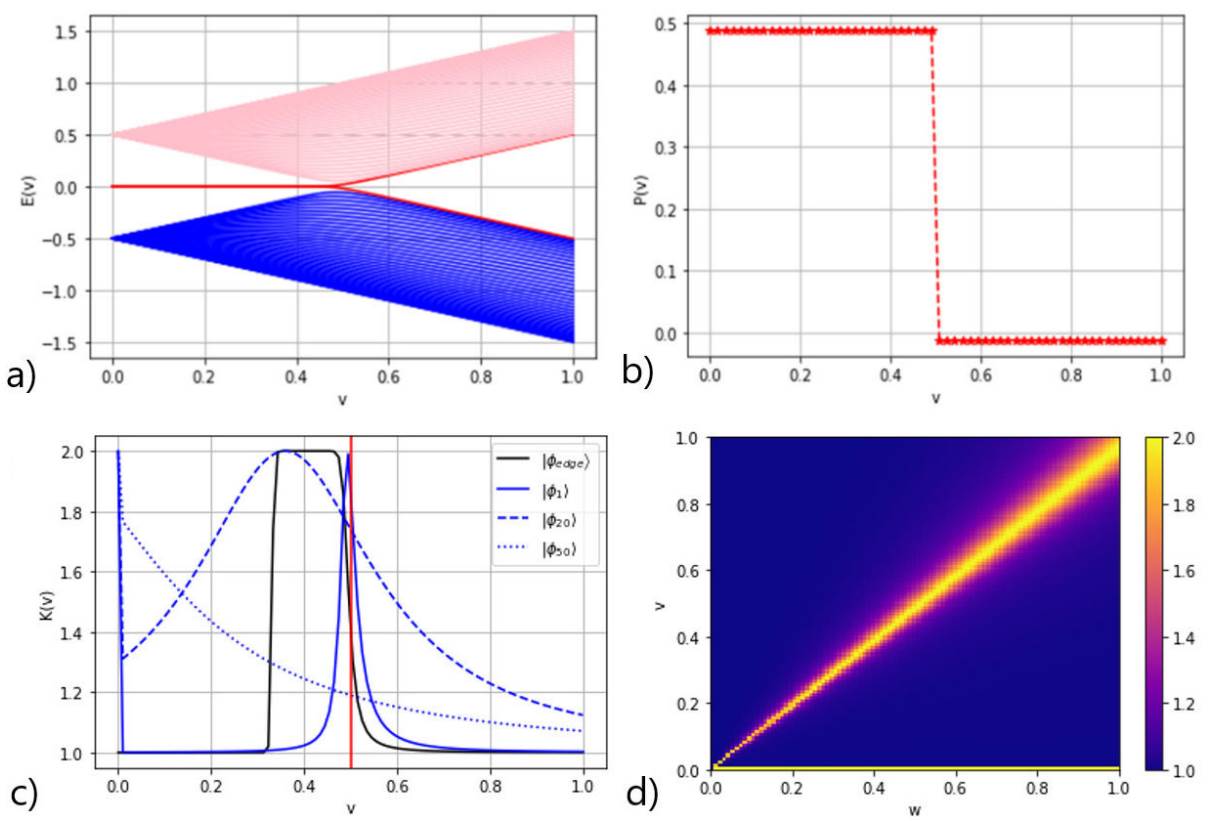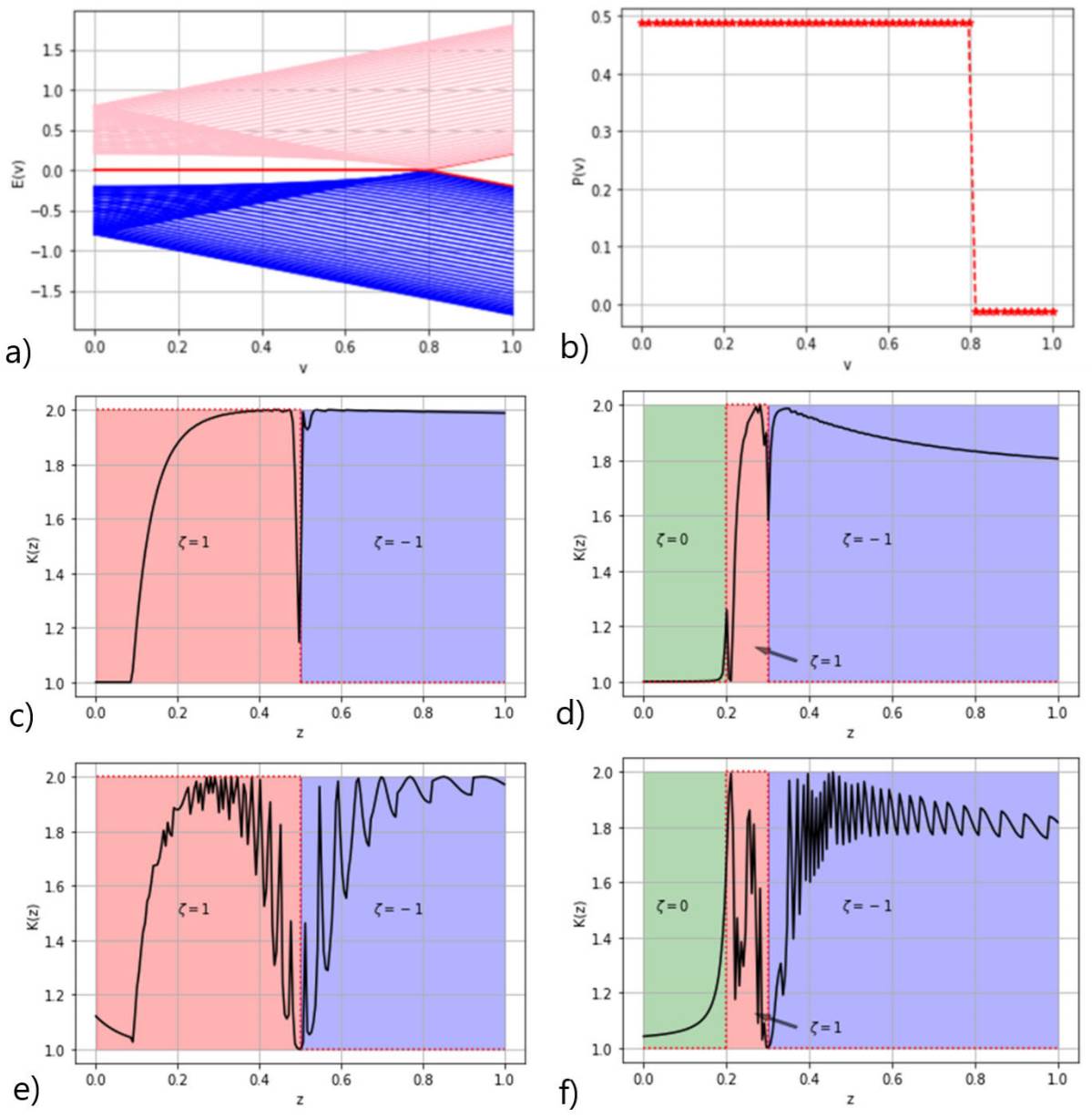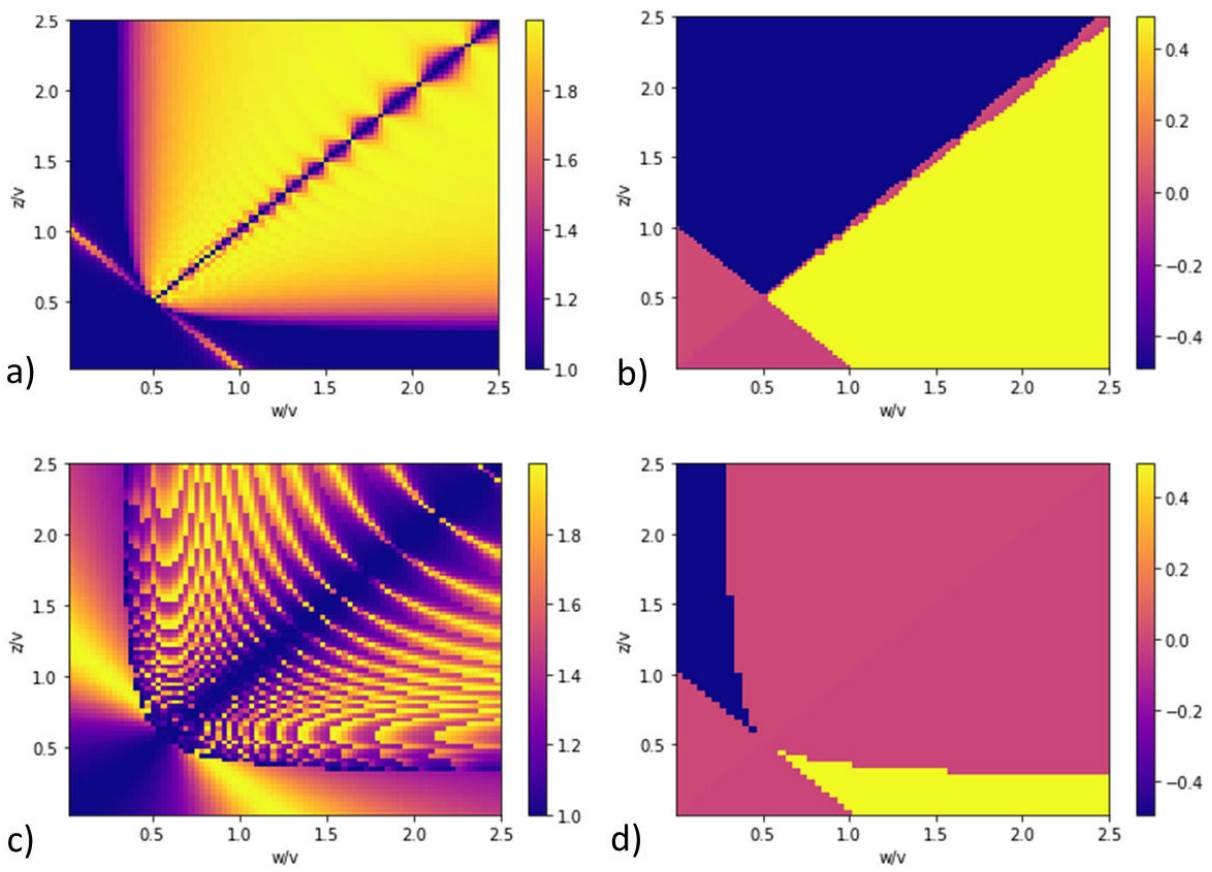1 Introduction
Topological systems promise to be materials with various implementations [1,2] in condensed matter physics. These materials gained interest in recent years due to their peculiar properties like efficient transport in electronic hetero-structures [3], high thermal conductivity [4], favorable mechanical properties under strains [5,6], minimization of thermal noise [7], and decoherence effects in open systems [8].
The property of topological robustness protects these materials from quantum fluctuations or defects in the system [9] and presents protected states, also known as zero-mode energy states [2].
There are already some works that mention peculiarities of these types of materials [2,8,10-13], and in general, due to the robustness of these materials, there are more quantum correlations which allow a greater degree of efficiency in electronic transport [14,15] related with the appearance of flat bands. Therefore, topological materials are expected to be suitable for quantum information processing [12,16-18].
One of the topics in quantum information theory is the study of entanglement and quantum correlations involved in condensed matter systems [19-21]. The origin of the relationship between quantum correlation metrics and geometric phases comes from the Fubini-Study geometrical quantum tensor of the complex projective space in the projective geometry of Hilbert space [22]. The connection between topological materials in condensed matter physics and manipulating qubits with entanglement properties in quantum information theory [23] opens a new research area to create new technology, like topological quantum computing, cryptography, and quantum security [24-26].
There are several experimental setups [27-31], that have been used to study some properties as anomalous transport, decoherence times, and thermal capacity. More recently, photonic systems and detection of topological states in light-matter devices have been broadly studied [32] as crystal photonic systems promise to have robust transport due to the presence of these protected gapless states [33].
In the SSH model, modulation of the hoppings generates a phase transition between a metal-insulator behavior due to the Piers instability of the hopping deformation. In this work, we present a characterization of the TPT via the Schmidt number metric [33,34] as a measure of entanglement in the simple [35,36] and extended [37] SSH models. Also, the relation entanglement-localization and topology are discussed.
2 1D SSH topological insulator
The system of study is the SSH Hamiltonian [32], which is a tight-binding model of a wire with alternating single and double hopping (Fig. 1). The basis of the wire is constructed by a cell of two types of atoms A and B.
The Hamiltonian in real space can be written as,
where z is the second neighbor hopping and

Figure 1 Extended SSH model. Topological wire, with intra v (black lines) and inter w (orange lines) hopping and an additional second neighborhood hopping z (green lines). The index m (dashed lines) indicates the cell number and atoms A (Red) and B (Blue), with N = 6 unit cells.
The eigenfunctions can be expanded as a superposition of the composite states,
The eigensolution of the Hamiltonian Eq. (1),
3 Geometrical phases and electrical polarization
To understand geometrical phases in our models, we characterized the phases in the k-space, and we provided a specific procedure to determine it in real space based on the calculation of electric polarization in periodic systems introduced by Resta [33].
The Hamiltonian in real space can reduce to a 2 ( 2 matrix in k-space as
which can be rewritten in terms of Pauli matrices as
The energy in k-space is given by
The topology of the 1D SSH model is characterized by the winding number that is related to the Berry phase or geometric phase for an adiabatic system [34]. The winding number for the extended Hamiltonian can be written as,
where C is the Brillouin zone
where the topological region (TR) is
For the extended SSH model
where the TR happens in
For
In the extended SSH model there are two points of TPT
However, geometrical phases are determined in k-space, where the system has periodic boundary conditions. Therefore we need to use another more convenient procedure in real space where the non-separable property of the bipartite system still remains. For this reason, we calculate the electrical polarization by the definition of Resta polarization [33,35],
where
4 Schmidt Number and entanglement
For the measure of entanglement we use the Schmidt number [39,40]. It is defined as the metric of entanglement in pure bipartite systems and can be described by bi-orthonormal wavefunctions as
where
The Schmidt number is also defined as the metric of entanglement for the SSH model in the reduced space of the qubit formed by the two-level system referred to as the type of atom A or B. The total dimension of the SSH model is
We considered that the hoppings are real numbers, therefore, the wave function of the eigenstate n is
The Schmidt number can be interpreted from a geometric point of view when the reduced density matrix represents a two dimensional system, in this condition the density matrix defines a Bloch vector of the form
Here we consider d = 2, due to the internal dimension of the basis atom
The hybrid entanglement is between cell sites and atoms, and must satisfy the conditions i)
The normalization for
In contrast to some other similar and also ‘natural’ definitions, K has the following desirable properties: a) it is independent of the representation of the wavefunction, so that, for example, K is the same in configuration and momentum space; b) K is also gauge invariant, which is important for systems in the presence of electromagnetic (laser) fields; and c) it obviously achieves its minimum value of 1 for the least correlated state.
An important case to analyze for entanglement aspects is the dimerized limit, the bulk in the fully dimerized limits has flat bands. These consist of even energy E = +1 and odd energy E = -1 superposition of two sites forming a dimer. Trivial dimerized case occurs for
these states has a Schmidt number,
therefore, in the topological dimerized limit, there is an entangled state with a maximum Schmidt number. On the other hand, trivial dimerized limit have normalized states as
and the corresponding Schmidt number is
Therefore, in the trivial dimerized limit, the system becomes disentangled. In both fully dimerized limits, the energy eigenvalues are independent of the wavenumber, E(k) = 1. In this so-called flat-band limit, the group velocity is zero, which again shows that as the chain falls apart to dimers, a particle input into the bulk will not spread along the chain. In k-space trivial and topological dimerized limits are
5 Results
5.1 Simple SSH z = 0
For the simple SSH model, two kinds of eigenstates can be distinguished: i) edge states, in the region

Figure 2 a) Energy spectrum in the simple SSH model for N = 40 unit cells, and inter-hopping w = 0.5 and the second neighbor hopping z = 0. b) Resta polarization for the quantum state
The SSH model has a spectrum of 2N eigenvalues
We observe that the TPT occurs in the singular point v = w according to the geometrical phase definition in Eq. (4). The eigenstate
The Schmidt number as function of
The edge state is the most robust in the region
In Fig. 2d) it is shown the entanglement diagram of eigenstate
Therefore,
5.2 Extended SSH z ≠ 0
For the extended SSH model, the energy spectrum is similar to the simple case; however, edge states appear in the region

Figure 3 a) Energy spectrum in the extended SSH model as function of v for N = 40 unit cells and w = 0.5 and z = 0.3. b) Resta polarization for the quantum state
The Fig. 3b) shows the electric polarization for the nearest states to the edge state
In Fig. 3c) for
On the other hand, in Fig. 3d) for
Note that the TPT points

Figure 4 Schmidt number and electric polarization diagrams in the extended SSH model as function of w and z for v = 0.4 and N = 300 unit cells. For
To obtain a general picture of the whole parameters space influencing on entanglement for the extended SSH model, the diagram of the electric polarization P(w/v,z/v) and the Schmidt number K(w/v,z/v) with an intra-hopping of v = 0.4 are shown in Figs. 4a)-d).
For
When z = 0, we recover the simple SSH model, and the critical transition point remains for
6 Conclusions
We studied the one-dimensional Su-Schrieffer-Heeger(SSH) topological insulator with first and second neighbor-hoppings. In the simple SSH model, the TPT
The extended SSH model with second neighbor hopping interaction
In general, the Schmidt number is a good metric of bipartite entanglement that characterizes TPT and regions with ME. The chiral Hamiltonian for the SSH model presents a robust relationship between TPT and states with ME. More importantly, the Schmidt number as a metric of entangled allows us to characterize the winding number as a topological invariant in the SSH model. There is a strong relationship between the Schmidt number and localization of the wavefunction because in the TPT both quantities have a local maximum.
A new paradigm towards understanding the behavior of these topological material’s properties opens the possibility to explore the hybrid nature of entangled states, as well as their potential application in quantum information processing. We only considered the effects mediated by hopping in a tight-binding model but would be desirable to study entanglement and topological phases for systems with more variety of interactions, couplings, long-range interaction, and spatial dimensions.











 text new page (beta)
text new page (beta)


